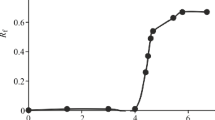Abstract
The method described for quantitative estimation of lipids separated on thin layer chromatography plates exploits the observation that most lipids can be stained by iodine vapor and that, in “controlled” conditions, the intensity of this staining is proportional to the actual amount of lipid in the spot. The method consists of i) exposing the developed plate to iodine vapor; ii) spraying it with a suitable solvent to prevent halogen evaporation; iii) collecting the stained lipids by scraping the spots off the plate; and iv) determining by a rate-sensing method the absorbed iodine. The final determination is performed by measuring spectrophotometrically (at 410 nm) the rate of decolorization of a solution of Ce(IV) by As(III) in strong acidic conditions. The reaction rate, which is positively related to the concentration of iodine, is derived from the slope of the absorbance change plotted vs time.
Providing that standards and samples are stained simultaneously, a quantitative estimation of lipid components of a mixture is possible in a reasonable time with excellent accuracy and reproducibility. In our hands, the method has been successfully applied to several common phospholipids, long chain fatty acids, cholesterol and deoxycholate, and triacylglycerols, in the range of 5–60 μg.
Similar content being viewed by others
References
Marinetti, G.V. (1964) inNew Biochemical Separations, Van Nostrand, Princeton, NJ, p. 339.
Mangold, H.K., and Malins, D.C. (1960)J. Am. Oil Chem. Soc. 37, 576–578.
Palumbo, G., Tecce, M.F., and Ambrosio, G. (1982)Anal. Biochem. 123, 183–189.
Sandell, E.B., and Kolthoff, I.M. (1937)Mikrochim. Acta 1, 9–25.
Gluck, L., Kulovitch, M.V., Borer, R.C. Jr., Brenner, P.H., Anderson, G.G., and Spellacy, W.N. (1971)Am. J. Obstet. Gynec. 109, 440–445.
Gluck, L., Kulovich, M.V., and Brady, S.J. (1966)J. Lipid Res. 7, 570–574.
Privett, O.S., and Blank, M.L. (1964)Off. Dig. J. Paint Technol. Eng. 36, 454–463.
Blank, M.L., Schmit, J.A., and Privett, O.S. (1964)J. Am. Oil Chem. Soc. 41, 371–376.
Wagner, H., Horhammer, L., and Wolff, P. (1961)Biochem. Z. 334, 175–184.
Jatzkewitz, H., and Mhel, E. (1960)Z. Physiol. Chem. 320, 251–257.
Ditmer, J.C., and Lester, L.R. (1964)J. Lipid Res. 5, 126–127.
Kundu, S.K., Chakravorty, S., Bhaduzi, N., and Saha, H.K. (1977)J. Lipid Res. 18, 128–130.
Bischel, M.D., and Austin, J.H. (1963)Biochim. Biophys. Acta 70, 598–600.
Skipsky, V.P., Smolowe, A.F., and Barclay, M. (1967)J. Lipid Res. 8, 295–299.
Schneider, P.B. (1966)J. Lipid Res. 7, 169–170.
Williams, J.N. Jr., Anderson, C.E., and Jasik, A.D. (1962)J. Lipid Res. 3, 378–381.
Coch, E., Meyer, J.S., Goldman, G., and Kessler, G.A. (1973)Clin. Chem. 19, 967–972.
Author information
Authors and Affiliations
About this article
Cite this article
Palumbo, G., Zullo, F. The use of iodine staining for the quantitative analysis of lipids separated by thin layer chromatography. Lipids 22, 201–205 (1987). https://doi.org/10.1007/BF02537303
Received:
Issue Date:
DOI: https://doi.org/10.1007/BF02537303




